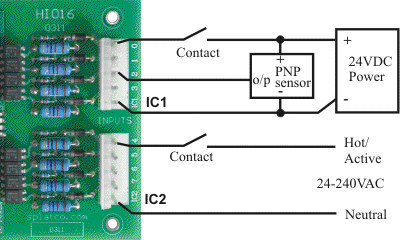HIO16: Connecting input devices
Note: This document is not yet complete. It may contain inaccuracies.
The 8 optically isolated logic inputs on the HIO16 are grouped into 2 groups of 4 inputs. Each group of 4 shares an Input Common, labeled IC1 and IC2 respectively. These input commons are not connected to each other or any other part of the circuit.
An input becomes activated (ON) when the input terminal is more than about 12V (24V guaranteed) positive relative to the common terminal. The input circuit can tolerate up to 400V positive, and it has a series diode that will resist up to 700V in the opposite polarity. With an AC voltage applied at 50Hz or 60Hz, the output of the optoisolator will pulsate on for each positive half-cycle. An onboard retriggerable 30mS timer stretches the pulses together to produce a continuous input signal to the SPLat controller whenever there is an AC input.
The input resistance is 47K for positive voltages and practically an open circuit for negative voltages. That means the circuit draws very little current. If you are driving the input off non-gold plated switch or relay contacts, the tiny current drawn by the HIO16 inputs may be insufficient to keep the contacts clean. Google for wetting current. There is an article about this here.

The above diagram shows how typical inputs can be connected. The top group of inputs are connected to a switch contact (input 0) and a PNP type sensor (input 2). A 24V DC power supply provides the necessary power for the sensor and to drive the input off the contact. Notice that the negative terminal of the power supply is connected to the input common (IC1). The other way around will not work.
The bottom group of inputs has one input driven off a contact with an AC supply. The AC can be between 24VAC and 240VAC. Notice that the AC neutral wire is connected to the input common (IC2). If you wired it the other way around there would be a small possibility of false triggering, especially on the high end of the voltage range and/or if there is a lot of electrical noise present. For similar reasons we suggest that you avoid dressing the input wires in close proximity to the relay wiring.
Note: We do not recommend that you can mix low voltage and high voltage across the two groups of inputs. See safety considerations.
